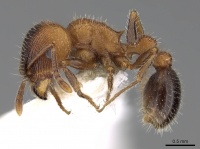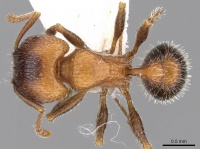Tetramorium dichroum
| Tetramorium dichroum | |
|---|---|

| |
| Scientific classification | |
| Kingdom: | Animalia |
| Phylum: | Arthropoda |
| Class: | Insecta |
| Order: | Hymenoptera |
| Family: | Formicidae |
| Subfamily: | Myrmicinae |
| Tribe: | Crematogastrini |
| Genus: | Tetramorium |
| Species group: | solidum |
| Species: | T. dichroum |
| Binomial name | |
| Tetramorium dichroum Santschi, 1932 | |
Tetramorium dichroum has been recorded from grassland with trees, and also in Karoo vegetation. This species nests in the soil and feeds on seeds.
Identification
Mbanyana et al (2018) - In the T. solidum species group, there are five species with abundant hairs covering the dorsal surfaces of the whole body, namely, Tetramorium rothschildi, Tetramorium peringueyi, Tetramorium dichroum, Tetramorium margueriteae and Tetramorium brigitteae. Tetramorium rothschildi is easily separated from other species by having branched hairs. Tetramorium dichroum can be easily distinguished from T. peringueyi and T. margueriteae by the absence of erect hairs on the antennal scapes. Tetramorium dichroum and T. brigitteae can be distinguished on the basis of the spine length: in T. dichroum spines are long and acute (PSLI 10–16), whereas T. brigitteae has very short propodeal teeth (PSLI 6).
Keys including this Species
- Key to Afrotropical Tetramorium solidum species group
- Key to Afrotropical Tetramorium solidum species group (Outdated)
Distribution
South Africa (Eastern Cape Province, southern parts of the Free State, Northern Cape and Western Cape Provinces) and Zambia.
Latitudinal Distribution Pattern
Latitudinal Range: -13.1667° to -33.75°.
| North Temperate |
North Subtropical |
Tropical | South Subtropical |
South Temperate |
- Source: AntMaps
Distribution based on Regional Taxon Lists
Afrotropical Region: South Africa (type locality), Zambia.
Distribution based on AntMaps
Distribution based on AntWeb specimens
Check data from AntWeb
Countries Occupied
| Number of countries occupied by this species based on AntWiki Regional Taxon Lists. In general, fewer countries occupied indicates a narrower range, while more countries indicates a more widespread species. |

|
Estimated Abundance
| Relative abundance based on number of AntMaps records per species (this species within the purple bar). Fewer records (to the left) indicates a less abundant/encountered species while more records (to the right) indicates more abundant/encountered species. |

|
Habitat
Known from Drakensberg Montane Grasslands, Kalahari Xeric Savanna, Montane Fynbos and Renosterveld, Nama Karoo, Succulent Karoo, Zambezian and Mopane Woodlands.
Biology
Castes
Nomenclature
The following information is derived from Barry Bolton's Online Catalogue of the Ants of the World.
- dichroum. Tetramorium solidum st. dichroum Santschi, 1932a: 388 (w.) SOUTH AFRICA. Subspecies of peringueyi: Prins, 1973: 11. Raised to species: Bolton, 1980: 245.
Unless otherwise noted the text for the remainder of this section is reported from the publication that includes the original description.
Description
Worker
Bolton (1980) - TL 3.7—3.9, HL 1.00-1.04, HW 0.97-1.00, CI 96-97, SL 0.65-0.67, SI 66-68, PW 0.64-0.66, AL 1.00-1.04 (2 measured).
Mandibles longitudinally rugose. Anterior clypeal margin with a broad, deep median impression or excavation which involves about half the length of the margin. Frontal carinae ending before level of midlength of eyes. Eyes relatively large, maximum diameter c. 0-22-0-24, the lower margin flattened in profile, the upper convex. Alitrunk in profile evenly convex dorsally, the propodeum armed with a pair of acute spines. Metapleural lobes blunt apically. Petiole in profile blocky, more massive than postpetiole; in dorsal view the petiole node broadest behind and somewhat narrower than the postpetiole. Head finely longitudinally rugulose from posterior margin of clypeus to occiput, but the rugulae less strongly developed posteriorly. Spaces between rugulae with very faint superficial reticulation. Dorsal alitrunk lightly and sparsely longitudinally rugulose, the interspaces with superficial punctulation and reticulation. Petiole and postpetiole similarly sculptured but the rugulae stronger than on the alitrunk and showing traces of a reticulate pattern in places. First gastral tergite punctulate-shagreened basally, sometimes also with a few very feeble rugulae. All dorsal surfaces of head and body with abundant short, stout hairs. Dorsal (outer) surfaces of mid and hind tibiae with short, stout, erect to suberect hairs which are also present elsewhere on the legs; antennal scapes with dense pubescence but without such hairs. Ammochaete hairs absent from ventral surface of head. Colour brown, the alitrunk tending to be a dull orange-brown, the head and gaster darker.
Mbanyana et al (2018) - (N = 11) HL 0.934–1.023 (0.987); HW 0.944–1.072 (1.003); SL 0.659–0.747 (0.703); EL 0.216–0.246 (0.237); PH 0.393–0.521 (0.451); PW 0.590–0.669 (0.638); WL 0.924–1.121 (1.015); PSL 0.098–0.157 (0.136); PTH 0.315–0.364 (0.341); PTL 0.275–0.354 (0.325); PTW 0.315–0.374 (0.343); PPH 0.315–0.491 (0.438); PPL 0.246–0.285 (0.267); PPW 0.382–0.457 (0.415); OI 23–25 (24); CI 100–105 (102); SI 66–73 (70); DMI 59–70 (63); LMI 39–52 (45); PSLI 10–16 (14); PeNI 50–57 (54); LPeI 85–100 (95); DPeI 99–114 (106); PpNI 61–70 (65); LPpI 50–80 (62); DPpI 144–186 (156); PPI 115–128 (121).
Type Material
Mbanyana et al (2018) - Syntypes South Africa: 3 pinned workers, Northern Cape, Kimberley, 1924, Power leg. (Naturhistorisches Museum, Basel: CASENT0915004; South African Museum: SAM-ENT-0011758).
References
- Bolton, B. 1980. The ant tribe Tetramoriini (Hymenoptera: Formicidae). The genus Tetramorium Mayr in the Ethiopian zoogeographical region. Bulletin of the British Museum (Natural History) Entomology. 40(3):193-384.
- Mbanyana, N., Hita Garcia, F., Robertson, H.G., Le Roux, J.J. 2018. A taxonomic revision of seed harvester ants of the Tetramorium solidum group (Hymenoptera: Formicidae) in southern Africa. European Journal of Taxonomy 454: 1–59 (DOI 10.5852/ejt.2018.454).
- Prins, A. J. 1973. African Formicidae (Hymenoptera) in the South African Museum. Description of four new species and notes on Tetramorium Mayr. Ann. S. Afr. Mus. 62: 1-40 (page 11, Subspecies of peringueyi)
- Santschi, F. 1932b. Formicides sud-africains. Pp. 381-392 in: Jeannel, R. (ed.) Société Entomologique de France. Livre du centenaire. Paris: Société Entomologique de France, xii + 729 pp. (page 388, worker described)
References based on Global Ant Biodiversity Informatics
- Bolton B. 1980. The ant tribe Tetramoriini (Hymenoptera: Formicidae). The genus Tetramorium Mayr in the Ethiopian zoogeographical region. Bulletin of the British Museum (Natural History). Entomology 40: 193-384.
- IZIKO South Africa Museum Collection
- Mbanyana N. 2013. Taxonomy, phylogeny and biogeography of seed-harvesting ants in the Tetramorium solidum-group (Hymenoptera: Formicidae). Masters of Science in the Department of Botany and Zoology at Stellenbosch University 115 pages.
- Prins A. J. 1973. African Formicidae (Hymenoptera) in the South African Museum. Description of four new species and notes on Tetramorium Mayr. Annals of the South African Museum 62: 1-40.
- Santschi F. 1932. Formicides sud-africains. Pp. 381-392 in: Jeannel, R. (ed.) 1932. Société Entomologique de France. Livre du centenaire. Paris: Société Entomologique de France, xii + 729 pp.

